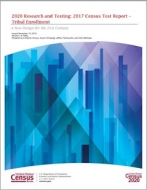2020 Research and Testing: 2017 Census Test Report – Tribal Enrollment
2020 Research and Testing: 2017 Census Test Report – Tribal Enrollment
Executive Summary
Study Overview
The 2017 Census Test (CT) was a nationwide self-response test that allowed the U.S. Census Bureau to assess the feasibility of collecting information on tribal enrollment, which is distinct from American Indian and Alaska Native (AIAN) racial identification.
To conduct this research, the 2017 CT was fielded with a Census Day of April 1, 2017, to a national sample of about 80,000 housing units, which included an oversample of housing units in tracts with higher concentrations of self-identified AIAN populations. The 2017 CT consisted of two parts, an initial self-response survey and a follow up reinterview component. The reinterview component further assessed the consistency of the self-response tribal enrollment questions. The reinterview included about 15,000 housing units from those that responded to the initial survey.
Background
The tribal enrollment questions were designed from two qualitative studies that preceded the 2017 CT, as well as tribal consultations and input from the Census Bureau’s National Advisory Committee on Racial, Ethnic, and Other Populations (NAC) and the National Congress of American Indians (NCAI), among others. Beginning in January 2016, 11 focus groups were conducted throughout the United States, including Alaska, to gain perspectives on the wording of the tribal enrollment questions from citizens of federally recognized tribes, state-recognized tribes, nonrecognized tribes, and Alaska Natives.
Coinciding with the focus groups, the Census Bureau conducted the first round of consultations with tribal leaders across the country. These consultations facilitated an intergovernmental discussion on a variety of topics, including the feasibility of testing a tribal enrollment question. The insights gained from the focus groups, the tribal consultations, and discussions with the NAC were used to design three sample questions to explore through 64 cognitive interviews in the summer of 2016. Given the findings from this research, new tribal enrollment questions, with different tribal enrollment and Alaska Native corporation shareholder question components, were designed to incorporate optimal terminology and wording from each of the three qualitatively tested forms. These versions were then quantitatively tested in the 2017 CT.
Results
Of the approximate 80,000 housing units that were sampled for the 2017 CT, 50.3 percent (standard error, 0.27 percent) responded, and of the approximate 15,000 housing units sampled for the reinterview, 58.6 percent (1.41) responded. Of those who responded to the 2017 CT, the item nonresponse rate was 2.5 percent (0.12) for the tribal enrollment question component and 2.6 percent (0.13) for the corporation shareholder question component (see Table 7). Of those who responded to the reinterview, the item nonresponse rate was 0.1 percent (0.08) for the tribal enrollment question component and 0.2 percent (0.73) for the corporation shareholder question component (see Table 8). All percentages and standard errors in the report are rounded values of the exact number.
The overall consistency rate of the tribal enrollment question component was 99.9 percent (0.03), the consistency rate of the checkbox part of the tribal enrollment question component was 99.9 percent (0.02), and the consistency of only the write-in reporting of the tribal enrollment question component was 77.4 percent (5.58).
The Alaska Native corporation shareholder question component had an overall consistency rate of 100 percent (0.01), the consistency of the checkbox part was 100 percent (0.00), and the write-in component consistency rate was 42.9 percent (28.48).
The write-in responses to the reinterview re-ask questions were compared with write-in responses of five questions regarding tribal enrollment status. The consistency rate between the reinterview re-ask questions and the write-in responses to the Alaska Native tribes question (Q5a) was 86.1 percent (10.26), the Alaska Native villages question (Q6a) was 63.9 percent (5.06), the Alaska Native councils question (Q7a) was 80.0 percent (6.26), the Alaska Native associations question (Q8a) was 38.1 percent (6.26), and the Alaska Native communities question (Q9a) was 73.3 percent (6.39). At the end of the reinterview, each respondent was presented with a summary question, which was designed to provide a final opportunity to correct any erroneous information regarding his or her recorded enrollment status. The correction rate for enrolled American Indians was 0.0 percent (0.02) and the correction rate for enrolled Alaska Natives was 0.3 percent (0.07).
Given the exploratory nature of this survey, these results should be interpreted with caution. Although the original intent of this study was to compare self-reported tribal enrollment responses with tribal enrollment records, this type of analysis was not possible. As such, we could not make conclusions about the validity of self-report tribal enrollment data. Rather, the findings from the 2017 CT assessed the feasibility of collecting tribal enrollment data in a census environment and are described only in terms of unit nonresponse, item nonresponse, and response consistency. Concerns from the NAC, from the NCAI, and from current tribal leaders regarding collecting tribal enrollment in a census environment ultimately lead to the decision to not include any tribal enrollment questions in the 2020 Census.






